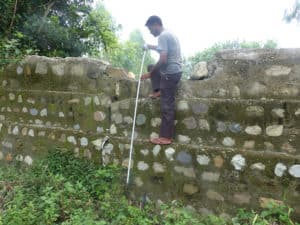Share this article
WSB: Adapting barriers keeps out wily elephants in India
Figuring out what kind of barrier will keep elephants from raiding farms in India is difficult—unless you can out-think one of the animal world’s top thinkers.
While revered by some in India, the massive pachyderms can be more than a nuisance to local farmers, many of whom practice subsistence agriculture. Elephant (Elephas maximus indicus) raids on crops can cause huge losses to profit margins.
This sometimes occurs in the Terai Arc Landscape, an area of protected ecosystems in India north of Delhi in the foothills of the Himalayas. “This area is one of the most fertile regions [for agricultural growth] of the world,” said Lakshminarayanan Natarajan, a wildlife biologist with the Elephant Cell and Department of Endangered Species Management at the Wildlife Institute of India, a technical arm of the national government.
Wildlife managers have tried using a number of different kinds barriers in that region to exclude elephants, from boulder piles, to traditional walls and even electrified fences. But the effectiveness of each kind of barrier depends on the situation.
“There is no silver bullet,” Natarajan said. “You cannot just think about one solution or strategy and expect that it works for all elephants.”

Measuring the damage made by an elephant to a wall. Credit: Lakshminarayanan Natarajan
Natarajan and his colleagues evaluated the different kinds of barriers managers used in the Terai Arc Landscape to keep out elephants. They published their findings in a study recently in Wildlife Society Bulletin. The area includes a mixture prime forested elephant habitats and agricultural areas. About 2,000 elephants live in this area—the Shiwalik region—but they don’t always stay put in the forested areas, which are a mixture of protected areas including Corbett National Park—India’s first national park—and Rajaji National Park, and multiple-use forests.
The elephants in this region are one of the four populations found in India, and conflicts with farmers are relatively minimal due to the large amount of connected wild land in the area compared to other parts of India with elephant populations, Natarajan said. “The primary conflict-resolution strategy is to try to contain them in the forest, because outside of it, there isn’t as much available habitat for them,” he said.
But the area is too large to build fences completely around it. Wildlife managers try to predict where elephants are likely to emerge. “The boundaries can be very diffuse at times,” Natarajan said.
Overall, he and his colleagues found that different kinds of barriers can work, but managers need to understand the situation well before making a decision on what to use. “No matter how strong your wall is, [elephants] are going to challenge your walls,” he said. “If elephants know how to break them, they will break them.”
One of the most effective barriers against elephants is the use of boulder piles.

A female elephant in the Rajaji area. Credit: Lakshminarayanan Natarajan
“These rubble walls are the first choice for wildlife managers building walls [in the Shivalik region],” Natarajan said, adding that Shivalik rivers weather down large quantities of boulders during monsoon season, which are readily available to use for these barriers. But if these piles are low, elephants can clamber over them. If they are too tall, they often become unstable, and elephants can push parts of them down with their heads and, if determined, get through the barriers.
In other areas, wildlife managers have used old railway tracks. Once the tracks become too eroded for their primary use, they can be set up on their sides to create a strong barrier to keep elephants out of some areas.
“Elephants cannot break them,” Natarajan said, but he added that these old tracks are expensive and typically only used in areas with acute levels of conflict between humans and elephants.
Other simpler walls can be effective in some cases, but determined elephants can break them down.
As a result, the researchers said it’s important to understand that these walls are partly psychological as well as physical. Just seeing the wall may be enough to ward off some individual elephants. But once an elephant is determined to get into an area, it’s difficult to stop it. Areas that have seen a lot of broken walls should consider alternative tactics like using noise to keep elephants away. Building the same type of physical barriers in these areas is likely a waste of time, he said.
Natarajan also said that, in some cases, local communities should still make some effort to keep watch over walls or areas where elephants might emerge from the forest.
“It should be backed by local communities—they should own it,” he said.
But he noted that just because one elephant breaks through a barrier and gets into a crop doesn’t mean the barrier has failed completely if it still keeps most individuals in the forest. Males, for example, are harder to control by barriers than adolescents and female elephants.
“Elephants are going to challenge you no matter what you do, so you have to keep trying,” Natarajan said. “We are dealing with a very intelligent species.”
This article features research that was published in a TWS peer-reviewed journal. Individual online access to all TWS journal articles is a benefit of membership. Join TWS now to read the latest in wildlife research.
Header Image:
Bull elephants along the Ganga River in the area of the Rajaji National Park.
Credit: Lakshminarayanan Natarajan








